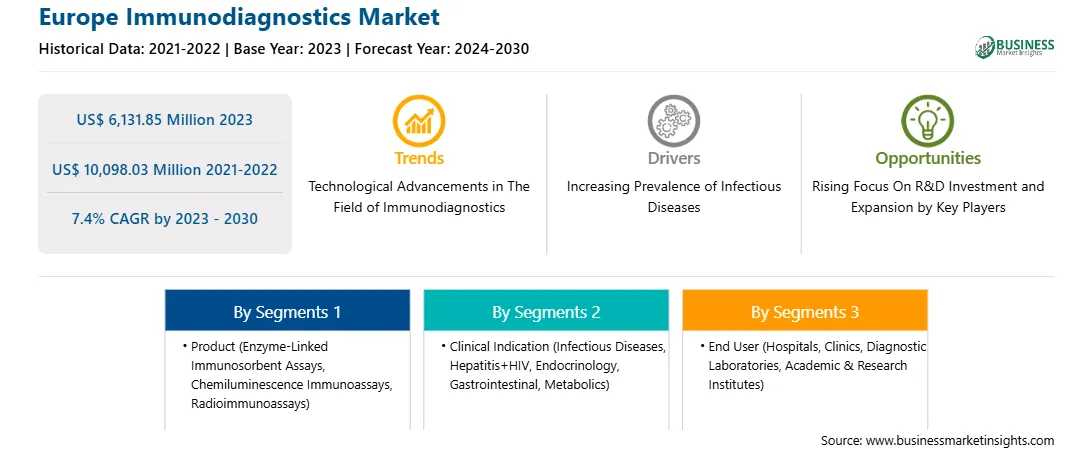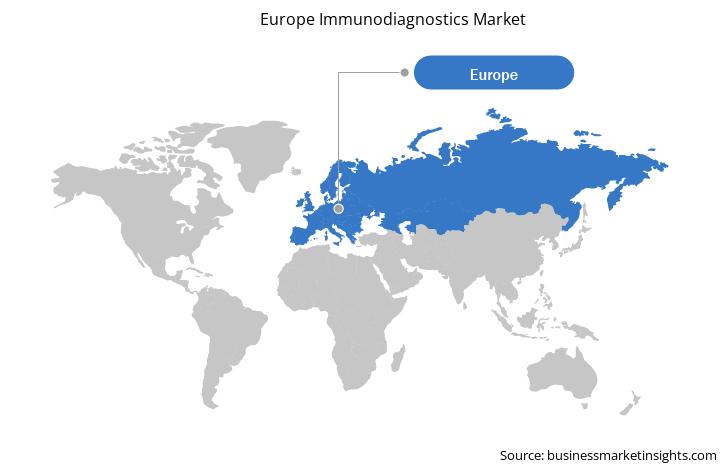The diagnosis and management of several ever-growing infectious diseases caused by infectious agents such as viruses, fungi, bacteria, parasites, or their toxic products are surging number of prescriptions for immunodiagnostics tests, e.g., complement fixation, precipitation tests, agglutination tests, line blot assays, Western blot assays, enzyme immunoassays (EIA), and immunofluorescence tests. Human immunodeficiency virus (HIV) continues to be a major public health issue worldwide. Further, tuberculosis (TB), COVID-19, and other hospital-acquired infections (HAIs) require immunodiagnostics tests.
• TB has been the 13th leading cause of death and the second-leading infectious killer after COVID-19. In 2020, 1.5 million people died from TB and affected an estimated 10 million people, comprising 5.6 million males, 3.3 million females, and 1.1 million children globally.
• According to Worldometer, millions of deaths were reported worldwide due to the COVID-19 pandemic. It strained healthcare systems and increased the need for immunodiagnostics tests.
Diagnostics play a vital role in determining suitable medical treatments. Immunodiagnostics help diagnose diseases that severely impact the immune system. Hence, the rising prevalence of infectious diseases lead to the surging demand for immunodiagnostics products.
The huge geriatric population is significantly driving the market for immunodiagnostics in Germany. According to the UN population data, 1 out of 20 Germans is aged above 80 years, and the number is expected to increase to 6 out of 20 by 2050. The risk of developing chronic diseases, such as cardiovascular diseases (CVDs), diabetes, and neurovascular disorders, increases with age. According to the estimates of the German Centre for Cancer Registry Data (ZfKD) published by the Robert Koch Institute in September 2023, in Germany, 502,655 people had cancer in 2019, among which 234,925 were women and 267,730 were men. It is estimated that the prevalence of cancer is likely to continue owing to lifestyle changes, obesity, unhealthy habits, and more. The most common cancers in Germany are breast, prostate, colorectum (large bowel), lung, and bladder cancer. These five cancer types accounted for about 57% of all new cancer diagnoses in Germany. Thus, the increasing prevalence of cancer is likely to propel the demand for immunodiagnostics.
Germany is the leading medical biotech nation in the world after the US. In 2020, the German biotechnology sector grew significantly compared to the pre-COVID year 2018. The positive market trend has accelerated in the last few years in some areas; and according to the OECD-compliant survey by BIOCOM, the German biotechnology industry’s turnover increased by almost 50% in 2020. The presence of long-established companies and the emergence of start-ups affirmed the industrial strength. Industry, government, and research sectors thrive on strong market foundations. With many European biotech companies, world-class research infrastructure, and internationally renowned scientists, Germany has firmly established itself as an international medical biotechnology hub. German biotech companies emerged as global leaders in mRNA technologies by introducing the first COVID-19 test and vaccination, approved by the European Medicines Agency. Such developments have encouraged enhanced technological advancements for immunodiagnostics. Thus, the rising biotechnology sector will likely boost the country's immunodiagnostics market.
Strategic insights for the Europe Immunodiagnostics provides data-driven analysis of the industry landscape, including current trends, key players, and regional nuances. These insights offer actionable recommendations, enabling readers to differentiate themselves from competitors by identifying untapped segments or developing unique value propositions. Leveraging data analytics, these insights help industry players anticipate the market shifts, whether investors, manufacturers, or other stakeholders. A future-oriented perspective is essential, helping stakeholders anticipate market shifts and position themselves for long-term success in this dynamic region. Ultimately, effective strategic insights empower readers to make informed decisions that drive profitability and achieve their business objectives within the market. The geographic scope of the Europe Immunodiagnostics refers to the specific areas in which a business operates and competes. Understanding local distinctions, such as diverse consumer preferences (e.g., demand for specific plug types or battery backup durations), varying economic conditions, and regulatory environments, is crucial for tailoring strategies to specific markets. Businesses can expand their reach by identifying underserved areas or adapting their offerings to meet local demands. A clear market focus allows for more effective resource allocation, targeted marketing campaigns, and better positioning against local competitors, ultimately driving growth in those targeted areas.
Europe Immunodiagnostics Strategic Insights

Europe Immunodiagnostics Report Scope
Report Attribute
Details
Market size in 2023
US$ 6,131.85 Million
Market Size by 2030
US$ 10,098.03 Million
Global CAGR (2023 - 2030)
7.4%
Historical Data
2021-2022
Forecast period
2024-2030
Segments Covered
By Product
By Clinical Indication
By End User
Regions and Countries Covered
Europe
Market leaders and key company profiles
Europe Immunodiagnostics Regional Insights

Europe Immunodiagnostics Market Segmentation
The Europe immunodiagnostics market is segmented into product, clinical indication, end user, and country.
Based on product, the Europe immunodiagnostics market is segmented into enzyme-linked immunosorbent assays (ELISA), chemiluminescence immunoassays (CLIA), radioimmunoassays (RIA), and others. In 2023, the enzyme-linked immunosorbent assays (ELISA) segment registered the largest share in the Europe immunodiagnostics market. The chemiluminescence immunoassays (CLIA) segment is further segmented into vitamin D assay market, HIV detection market, HIV ag/ab combo assay market, and other tests.
Based on clinical indication, the Europe immunodiagnostics market is segmented into infectious diseases, hepatitis+hiv, endocrinology, gastrointestinal, metabolics, and others. In 2023, the infectious diseases segment registered the largest share in the Europe immunodiagnostics market. The infectious diseases segment is further segmented into COVID-19, tuberculosis, lyme, infection management, zika, treponema, torch, measles and mumps, VZV, and EBV. The endocrinology segment is further segmented into hypertension, growth, diabetes, thyroid, and reproductive endocrinology.
Based on end user, the Europe immunodiagnostics market is segmented into hospitals, clinics, diagnostic laboratories, academic & research institutes, and others. In 2023, the hospitals segment registered the largest share in the Europe immunodiagnostics market.
Based on country, the Europe immunodiagnostics market is segmented into Germany, France, the UK, Italy, Spain, and the Rest of Europe. In 2023, Germany segment registered the largest share in the Europe immunodiagnostics market.
Abbott Laboratories; bioMerieux SA; Danaher Corp; DiaSorin SpA; F. Hoffmann-La Roche Ltd; PerkinElmer Inc; Shenzhen Mindray Bio-Medical Electronics Co., Ltd.; Siemens Healthcare GmbH; Svar Life Science AB; and Thermo Fisher Scientific Inc are some of the leading companies operating in the Europe immunodiagnostics market.
The Europe Immunodiagnostics Market is valued at US$ 6,131.85 Million in 2023, it is projected to reach US$ 10,098.03 Million by 2030.
As per our report Europe Immunodiagnostics Market, the market size is valued at US$ 6,131.85 Million in 2023, projecting it to reach US$ 10,098.03 Million by 2030. This translates to a CAGR of approximately 7.4% during the forecast period.
The Europe Immunodiagnostics Market report typically cover these key segments-
The historic period, base year, and forecast period can vary slightly depending on the specific market research report. However, for the Europe Immunodiagnostics Market report:
The Europe Immunodiagnostics Market is populated by several key players, each contributing to its growth and innovation. Some of the major players include:
The Europe Immunodiagnostics Market report is valuable for diverse stakeholders, including:
Essentially, anyone involved in or considering involvement in the Europe Immunodiagnostics Market value chain can benefit from the information contained in a comprehensive market report.